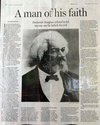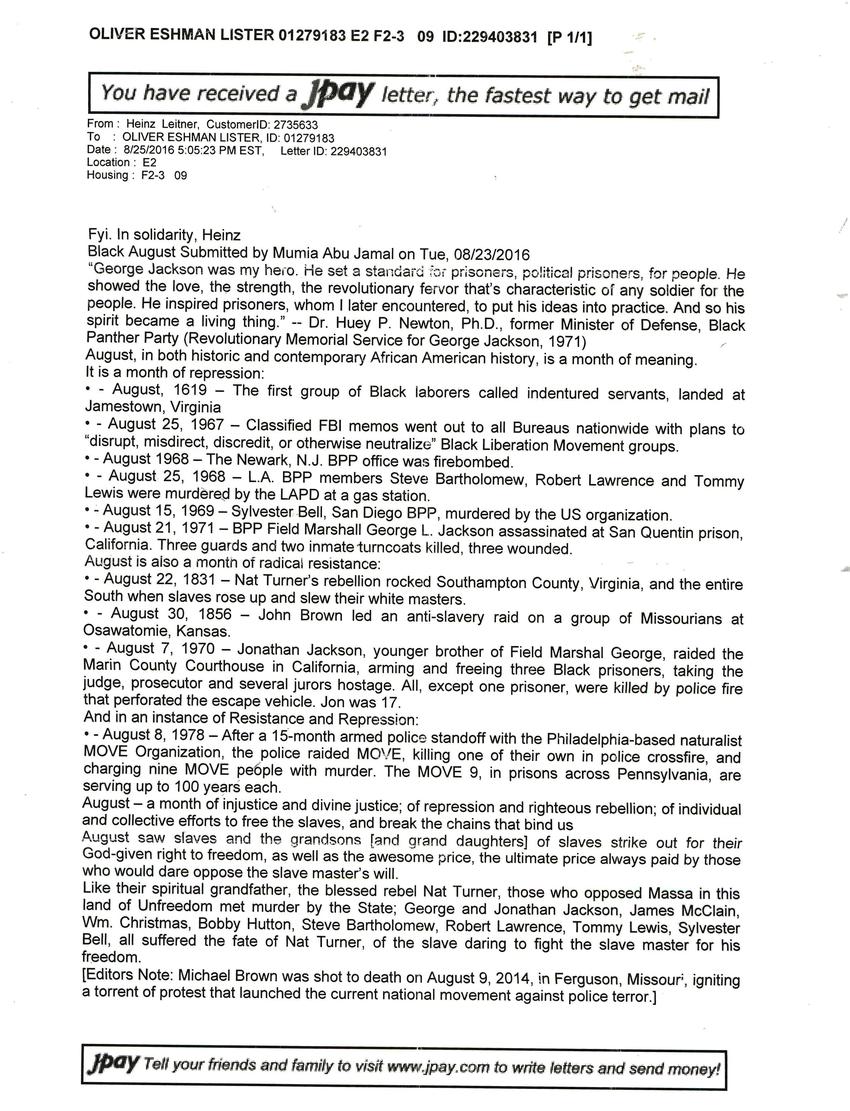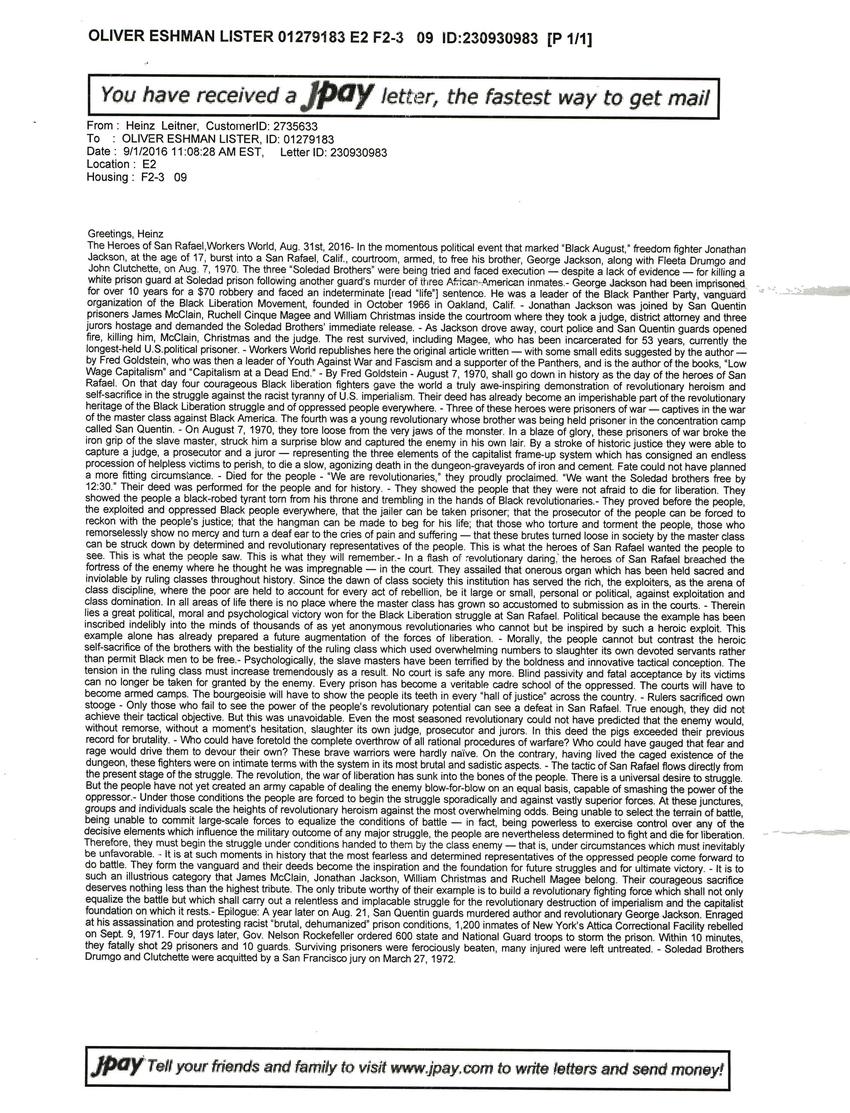
Transcription
OLIVER ESHMAN LISTER 01279183 E2 F2-3 09 ID:229403831 [P 1/1]
You have received a jpay letter, the fastest way to get mail
From: Heinz Leitner, CustomerID: 2735633
To : OLIVER ESHMAN LISTER, ID: 01279183
Date: 8/25/2016 5:05:23 PM EST, Letter ID: 229403831
Location: E2
Housing: F2-3 09
Fyi. In solidarity, Heinz
Black August Submitted by Mumia Abu Jamal on Tue, 08/23/2016
"George Jackson was my hero. He set a standard for prisoners, political prisoners, for people. He showed the love, the strength, the revolutionary fervor that's characteristic of any soldier for the people. He inspired prisoners, whom I later encountered, to put his ideas into practice. And so his spirit became a living thing." -- Dr. Huey P. Newton, Ph.D., former Minister of Defense, Black Panther Party (Revolutionary Memorial Service for George Jackson, 1971)
August, in both historic and contemporary African American history, is a month of meaning.
It is a month of repression:
. - August, 1619 - The first group of Black laborers called indentured servants, landed at Jamestown, Virginia
. - August 25, 1967 - Classified FBI memos went out to all Bureaus nationwide with plans to "disrupt, misdirect, discredit, or otherwise neutralize" Black Liberation Movement groups.
. - August 1968 - The Newark, N.J BPP office was firebombed.
. - August 25, 1968 - L.A. BBP members Steve Bartholomew, Robert Lawrence and Tommy Lewis were murdered by the LAPD at a gas station.
. - August 15, 1969 - Sylvester Bell, San Diego BPP, murdered by the US organization.
. - August 21, 1971 - BPP Field Marshall George L. Jackson assassinated at San Quentin prison, California. Three guards and two inmate turncoats killed, three wounded.
August is also a month of radical resistance:
. - August 22, 1831 - Nat Turner's rebellion rocked Southampton County, Virginia, and the entire South when slaves rose up and slew their white masters.
. - August 30, 1856 - John Brown led an anti-slavery raid on a group of Missourians at Osawatomie, Kansas.
. - August 7, 1970 - Jonathan Jackson, younger brother of Field Marshal George, raided the Marin County Courthouse in California, arming and freeing three Black prisoners, taking the judge, prosecutor and several jurors hostage. All, except one prisoner, were killed by police fire that perforated the escape vehicle. Jon was 17.
And in an instance of Resistance and Repression:
. - August 8, 1978 - After a 15-month armed police standoff with the Philadelphia-based naturalist MOVE Organization, the police raided MOVE, killing one of their own in police crossfire, and charging nine MOVE people with murder. The MOVE 9, in prisons across Pennsylvania, are serving up to 100 years each.
August-a month of injustice and divine justice; of repression and righteous rebellion; of individual and collective efforts to free the slaves, and break the chains that bind us
August saw slaves and the grandson [and grand daughter] of slaves strike out for their God-given right to freedom, as well as the awesome price, the ultimate price always paid by those who would dare oppose the slave master's will.
Like their spiritual grandfather, the blessed rebel Nat Turner, those who opposed Massa in this land of Unfreedom met murder by the State; George and Jonathan Jackson, James McClain, Wm. Christmas, Bobby Hutton, Steve Bartholomew, Robert Lawrence, Tommy Lewis, Sylvester Bell, all suffered the fate of Nat Turner, of the slave daring to fight the slave master for his freedom.
[Editor's Note: Michael Brown was shot to death on August 9, 2014, in Ferguson, Missouri, igniting a torrent of protest that launched the current national movement against police terror.]
jpay Tell your friends and family to visit www.jpay.com to write letters and send money!
Prison reform must get 'smart on people'
Focus should be more on rehabilitation, assessment in an effort to decrease recidivism rate across the state
By Jennifer Erschabek
As lawmakers get ready for the next legislative session, grappling with the budget is a priority.
Official recently discussed reducing the Texas Department of Criminal Justice's budget by 4 percent by targeting "layoffs of correctional officers and reducing inmate health care, meals, and prison and parole operations." Texas could do more without compromising public safety.
Jerry McGinty, a TDCJ official, recently said that "it has been projected that TDCJ inmate population is expected to remain the same over the next five years." I would argue that it is the number of people admitted to prison and how long each person must stay that directly affects the cost of the Texas prison system; the costs of correctional health care, personnel and other support add up quickly.
The main driver of the issue of over-incarceration in Texas falls squarely on the shoulders of legislators. They write laws that allow or require longer prison terms for certain types of offenses and longer percentage of sentences that must be served behind bars.
Legislators allow prosecutorial and judicial discretion with little accountability, prosecutors and sheriffs to protest parole, and the parole board's use of inadequate and subjective assessment tools in determining who qualifies for parole.
As a state, Texas has increased the average length of stay for people incarcerated, according to a 2012 study conducted by the Pew Center on the States. Texans now serve 36 percent more times than those released in 1990.
Even former Gov. Rick Perry recently said there is a problem with prosecutors when the gavel of the criminal justice system falls heavier on poorer communities and communities of color. "And when it comes to prosecutors, there are clearly bad apples in the system who care more about indicating someone - anyone - than they care about convicting the right person."
And "When ambitious prosecutors go overboard, the true victims... are the people who don't have the means to fight back."
Now a report, "Crime Survivors Speak," which came out in April 2016, finds that victims of crime say they want to see shorter prison sentences, less spending on prisons and a greater focus on the rehabilitation of criminals.
The easy solution to release nonviolent drug offenders is not the only solution. There must be some proportionality of the sentence to the crime, even for violent crimes.
Currently, TDCJ has approximately 82,484 people interned who have committed violent crimes, and most are required to serve half of their sentence before parole eligibility. In reality, these people serve approximately 66 percent of their respective sentences.
Thirty-five thousand prisoners with violent offenses are eligible for parole.
Releasing these people based on a thorough assessment of rehabilitation, institutional behaviour and work ethic and releasing them just one year earlier to parole, at the current cost of $54 per day to house them, would save the state $690 million a year. (There are a total of 73,166 offenders currently eligible for parole, equalling a cost of $1.44 billion per year.)
Violent crimes absolutely deserve serious punishment.
But we should not ignore or excuse irrationally harsh punishment simply because a person has done something violent.
The excessive sentences and low rate of parole for these individuals is counterproductive, costly and inhumane.
Lawmakers and government officials looking for ways to cut the budget without compromising public safety should allow prisoners to earn time toward their eligibility for parole.
All people serving time in TDCJ should receive diligent participation credit for the successful completion of an educational, vocational, substance abuse treatment or work program while confined.
This time would be included in the calculation of time needed to be eligible for a parole review and not a sentence reduction.
This solution will improve safety by incentivizing recidivism-reduction program participation and giving prisoners something to work for.
More focus and credit should be given to rehabilitation and assessment, and these men and women should be allowed to return home when they have paid for the crime committed.
We can intelligently reduce the sentences for violent offenses without compromising public safety.
Texas, let's not only get smart on crime, let's get "smart on people."
Erschabek is executive director of Texas Inmate Families Association.
OLIVER ESHMAN LISTER 01279183 E2 F2-3 09 ID:230930983 [P 1/1]
You have received a jpay letter, the fastest way to get mail
From: Heinz Leitner, CustomerID: 2735633
To: OLIVER ESHMAN LISTER, ID: 01279183
Date: 9/1/2016 11:08:28 AM EST, Letter ID: 230930983
Location: E2
Housing: F2-3 09
Greetings, Heinz
The Heroes of San Rafael, Workers World, Aug. 31st, 2016- In the momentous political event that marked "Black August," freedom fighter Jonathan Jackson, at the age of 17, burst into a San Rafael, Calif., courtroom, armed, to free his brother, George Jackson, along with Fleeta Drumgo and John Cluchette, on Aug. 7, 1970. The three "Soledad Brothers" were being tried and faced execution - despite a lack of evidence - for killing a white prison guard at Soledad prison following another guard's murder of three African-American inmates. George Jackson had been imprisoned for over 10 years for a $70 robbery and faced an indeterminate [read "life"] sentence. He was a leader of the Black Panther Party, vanguard organization of the Black Liberation Movement, founded in October 1966 in Oakland, Calif. - Jonathan Jackson was joined by San Quentin prisoners James McClain, Ruchell Cinque Magee and William Christmas inside the courtroom where they took a judge, district attorney and three jurors hostage and demanded the Soledad Brothers' immediate release. - As Jackson drove away, court police and San Quentin guards opened fire, killing him, McClain, Christmas and the judge. The rest survived, including Magee, who has been incarcerated for 53 years, currently the longest-held U.S. political prisoner. - Workers World republishes here the original article written - with some small edits suggested by the author - by Fred Goldstein, who was then a leader of Youth Against War and Fascism and a supporter of the Panthers, and is the author of the books, "Low Wage Capitalism" and "Capitalism at a Dead End." - By Fred Goldstein - August 7, 1970, shall go down in history as the day of the heroes of San Rafael. On that day four courageous Black liberation fighters gave the world a truly awe-inspiring demonstration of revolutionary heroism and self-sacrifice in the struggle against the racist tyranny of U.S. imperialism. Their deed has already become an imperishable part of the revolutionary heritage of the Black Liberation struggle and of oppressed people everywhere. - Three of these heroes were prisoners of war - captives in the war of the master class against Black America. The fourth was a young revolutionary whose brother was being held prisoner in the concentration camp called San Quentin. - On August 7, 1970, they tore loose from the very jaws of the monster. In a blaze of glory, these prisoners of war broke the iron grip of the slave master, struck him a surprise blow and captured the enemy in his own lair.
Other posts by this author
|
2021 dec 19

|
2020 jul 11

|
2020 jul 6

|
2020 jul 2

|
2020 jun 30

|
2018 dec 13

|
More... |




Replies